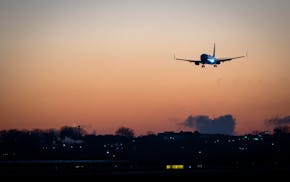Housing construction in the Twin Cities last year fell to its lowest level in several years despite a late rally for single-family homes.
During 2023, Twin Cities builders garnered 5,692 permits to build 10,638 houses and apartments, according to a year-end report from Housing First Minnesota. That was a 35% annual decline and the fewest new housing permits since at least 2019.
"Home building went for a ride this year as interest rates impacted all areas of the market," said John Quinlivan, a Twin Cities home builder and 2023 board chair of Housing First Minnesota, in a statement.
A steep and steady decline in apartment permits led the downswing last year, but a shortage of previously owned homes helped boost demand for single-family houses during the later months.
In December, metro-area builders pulled 401 single-family permits, a 51% increase from the same time last year, while apartment developers took only enough permits to build 214 units, a 59% decrease compared to last year.
Multifamily housing accounted for nearly half of all permitted units in the metro last year, but apartment developers have been facing increasingly challenging market conditions at a time when developers are already expected to deliver a near-record number of rentals. That caused a steep drop-off in multifamily permits.
Permits come before construction begins, so they're a reflection of future completions. Last year, developers completed a near-record number of apartments, but that's not likely to be the case during 2024. Higher borrowing costs and declining values in a some parts of the metro are making it more difficult for owners to refinance their existing buildings and obtain financing to build new ones.
Marquette Advisors said it expected builders to complete about 10,400 new units in 2023, following 18,000 completions in both 2021 and 2022. This year, apartment deliveries should slow to around 7,000 new units, most of them in the suburbs.
As of the end of September, the latest data available, the average apartment vacancy rate across the metro was 5.2%, including new supply in lease-up. But that figure will likely crest at 6% early this year.
That's forcing many building managers to offer concessions in the form of a month or two of free rent and other perks to help attract tenants, a trend that should continue into 2024. In some southwest suburbs as well as downtown Minneapolis, for example, the average vacancy rate already exceeds 5% and will probably increase even more in the coming months. At 5%, the market is evenly balanced between supply and demand.
Though higher mortgage rates have been a budget-buster for many new home buyers, builders said buyers who can't find a previously owned home are buying new. That was especially true during the last quarter of the year as rates posted moderate declines.
"Buyer demand remains high, and conditions in the existing market continue to steer more buyers to purchasing newly built homes," Quinlivan said.
In fact, while existing home sales in the Twin Cities last year were down slightly compared to the previous year, new home sales increased in part because of a double-digit increase in newly built townhomes.
By the end of November, there had been slightly more than 3,900 pending sales of new single-family homes across the metro, a 1% increase from the previous 12-month period, according to Minneapolis Area Realtors. New townhomes posted a more than 30% increase in annual sales.
Minneapolis permitted 1,553 new units, mostly market-rate rentals, making it by far the busiest city for housing construction in the metro last year. Rosemount was No. 2 with nearly half as many units, with Lakeville not far behind.

In a first, Minnesota doctors walk their own picket line, then hustle to see patients
It's harder to find a job this year, especially a corporate position

Delta hiked fares for solo travelers, until Twin Cities travel experts caught the change

In first speech back, UnitedHealth's new CEO pledges to review hot-button issues
